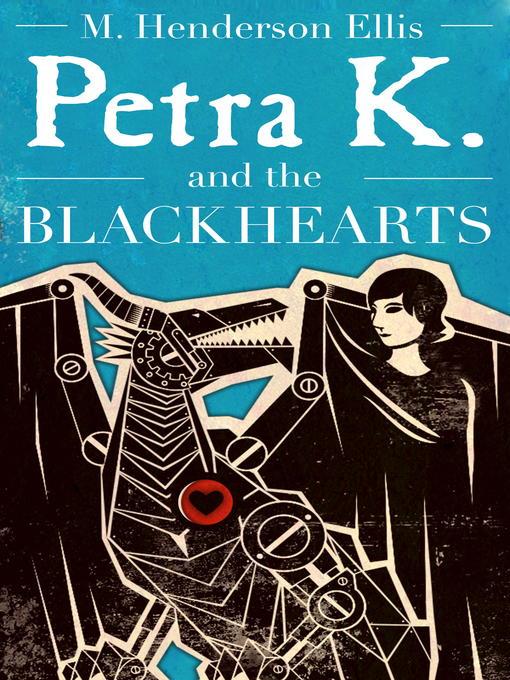
Petra K and the Blackhearts
A Novel
فرمت کتاب
ebook
تاریخ انتشار
2014
نویسنده
M. Henderson Ellisناشر
Steerforth Pressشابک
9780985062392
کتاب های مرتبط
- اطلاعات
- نقد و بررسی
- دیدگاه کاربران
نقد و بررسی

March 3, 2014
Adult novelist Ellis's (Keeping Bedlam at Bay In the Prague Café) years living in Eastern Europe give this steampunk fantasy, first in a planned trilogy, a strong sense of place and an unerring ear for the newspeak of totalitarianism. Archibald the Precious, a child dictator known to the Youth Groups that revere him as the "Number One Play Pal," takes the reins in Pava, the crumbling city-state in which Petra K lives. Archibald forbids the holding or showing of dragonka, magnificent animals trained to compete in spectator-delighting matches of strategy. When Petra K finds herself in possession of a dragonka she's not supposed to have, her innate distrust puts her at odds with her invalid mother, her brown-nosing classmates, and the Blackhearts, the child gang that runs through the streets of the capital's ghetto, Jozsefstown. Ellis's pacing and plotting abilities show considerable gifts as Petra draws closer to the secret of Archibald's power; the prose itself is just enough to keep the narrative afloat: "But I had no choice but to be Petra Kâand if that meant being alone, then that is what I would accept." Ages 14âup.

January 15, 2014
A breathless--for the most part page-turning--adventure pits a poor, fatherless girl against all sides in a battle for a dragon's heart and a city's freedom. Petra is clearly the odd girl out when her class goes on a field trip to Ludmilla's Cosmetics Emporium, and she's the only one to receive a vial of perfume distilled from the mystical song of a dragonka (a descendent of ancient dragons)--launching events that culminate in revolution. An apparent epidemic of "dragonka fever" allows the monarchy's police force, the Boot, to impose martial law on behalf of the child emperor, Archibald the Precious. As the city falls under oppression, Petra is occupied with the young dragonka she saves from a deliberate drowning. A permeable divide between living and dead is revealed to be evil at work, and Petra and a ragtag gang of orphans, the Blackhearts, must free the city from an ancient curse revived. Meticulously imagined, Petra's city is built on ancient layers of cultures and traditions, with magic woven into its fabric. Marvelous descriptions of the city in decline, its vast mysterious underground, and the dragonka and their magical variety provide a foundation almost too rich for the intriguing but thinly supported plot. The character of first-person narrator Petra is nuanced, but she has her moments of blankness, as if the author abandoned her to dash to the next scene. Nevertheless, a remarkable and distinctive offering for devoted fantasy fans. (Fantasy. 10-14)
COPYRIGHT(2014) Kirkus Reviews, ALL RIGHTS RESERVED.

May 1, 2014
Gr 5-8-Petra K lives in Pava, a fantastical city similar to Prague. It is a city full of strange and fascinating creatures, including miniaturized dragons, called dragonka, which are bought and sold at a high prices as pets. But times are quickly changing under the rule of evil child dictator, Archibald the Precious. Under his leadership, magic-and therefore the existence of dragonka-is outlawed. Petra happens upon a dragonka, which sends her on a journey into the underworld of Pava, where the miniature dragons are pitted against one another in forbidden tournaments, and child gangs roam the streets. When Petra finds herself drawn into one such gang, the Blackhearts, she also finds herself at the center of a revolution to overthrow Archibald and return the dragonka to their rightful, treasured place in society. While the story has a strong start, it quickly meanders into uneven world-building, with many fantastical elements not fully developed or simply abandoned. Petra seems more of a spectator than a real participant in her story and her first-person narration seems too mature and detached. The story bears many similarities to Marie Rutkoski's The Cabinet of Wonders(Farrar, 2008), which also features a girl named Petra living in an alternate Prague run by an evil ruler.-Necia Blundy, formerly at Marlborough Public Library, MA
Copyright 2014 School Library Journal, LLC Used with permission.

























دیدگاه کاربران